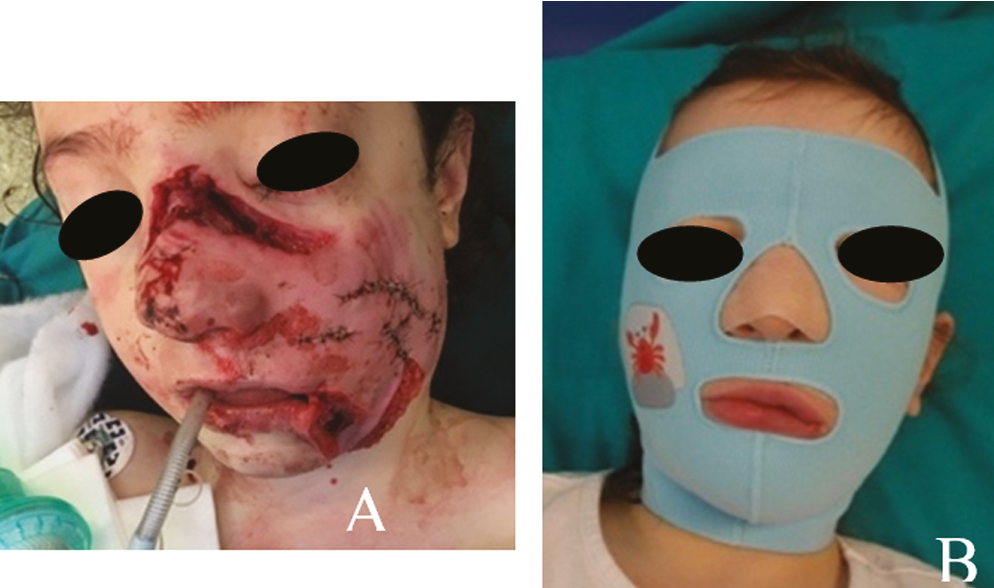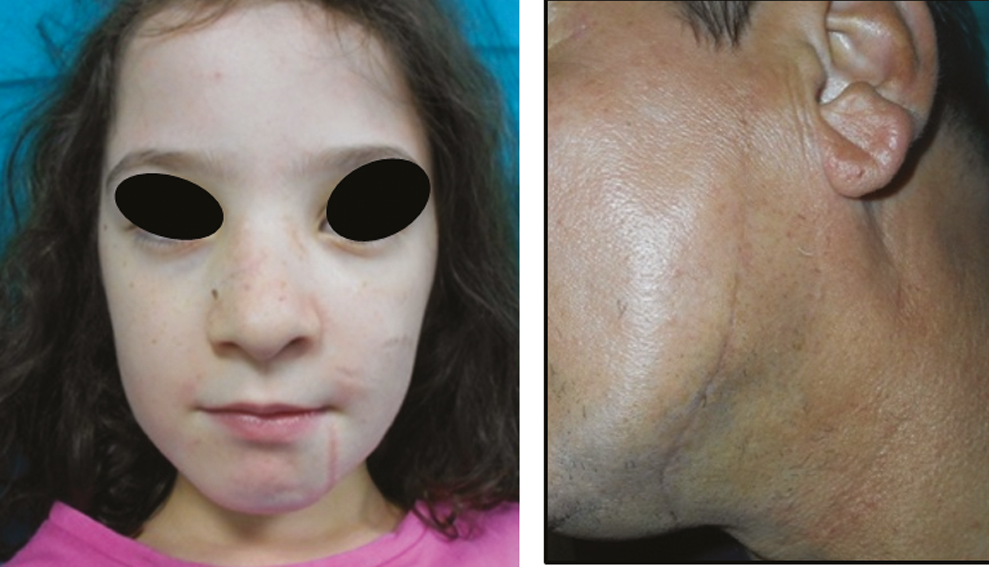Translate this page into:
Pressure Garment Therapy with Custom Facial Mask in Complex and Traumatic Facial Wounds: Case Series
Address for correspondence: Dr. Alejandro Juan Piza Moragues, Department of Maxillofacial Surgery, University of Milano-Bicocca, San Gerardo Hospital, Monza, Lombardia 20900, Italy. E-mail: a.pizamoragues@campus.unimib.it
This article was originally published by Wolters Kluwer - Medknow and was migrated to Scientific Scholar after the change of Publisher.
Abstract
Abstract
Pressure garment therapy is frequently used to prevent pathologic scarring, especially in burns. Less common is its use for the treatment of facial wounds. Pathologic scarring can create functional and aesthetic problems, which can have psychological implications. The aim of this study is to report our experience in the treatment of traumatic facial wounds using an elastic custom facial mask.
Keywords
Facial trauma
hypertrophic scar
keloid scar
pathologic scarring
pressure garment therapy
pressure therapy
scarring
wound healing
INTRODUCTION
A lot of people develop scars as a result of trauma. Scars have functional, aesthetic, psychological, and physical implications.[12] Obviously, consequences are more relevant when the affected area is such important as the face.
Face injury can have serious consequences in our social and working life, involving self-esteem problems that could lead to depression and anxiety.[2]
In literature, there are a lot of references about the use of pressure garment therapy (PGT), especially in the field of burns where it is frequently used on the limbs or chest regions. Nevertheless, the use of this therapy for traumatic face injuries is less widespread.
Although compression therapy is widely used, its action in wound healing is not yet well defined. It is hypothesized that compression decreases the proliferation of fibroblasts through ischemia, reducing the flow of both oxygen and inflammatory signals.[3] In particular, there is an increased transforming growth factor-beta (TGF-B) secretion. Higher levels of TGF-B are considered a risk factor for hypertrophic and keloid scar development.[4]
There are currently no works in the literature describing and evaluating the PGT using an elastic custom-made facial mask in facial wounds.
The aim of this study is to describe a single-center experience with PGT in the management of scar healing in complex facial wounds and analyze the most recent literature to compare their results to similar methods.
MATERIALS AND METHODS
A flat texture custom mask has been used (Juzo Aichach, Germany). The components of the sheat are polyamide, elasthane, and some incorporate silver or cotton.
The mask exerted pressure between 23–32 mmHg. The pressure range between 15 and 25 mmHg is considered to be functional and safe, whereas pressure above 30 mmHg may be harmful.[5]
To evaluate the scarring outcomes, two validated subjective scales have been used. The classic Vancouver Scar Scale (VSS) and the Manchester Scar Scale (MSS) with scar ranking, which is specifically used for the evaluation of photographic documentation[6] [Table 1].
| Scar scales | Vancouver | Manchester | |||
|---|---|---|---|---|---|
| Before treatment | 1 year after treatment | Before treatment | 1 year after treatment | ||
| Lower lip-chin wound | 10 | 3 | 17 | 7 | |
| Case 1 | Submalar wound | 8 | 1 | 15 | 6 |
| Naso-infraorbital wound | 6 | 1 | 11 | 5 | |
| Case 2 | Parotid-Masseteric wound | 6 | 1 | 10 | 4 |
We present two cases of complex and traumatic facial wounds, classified with a 5 score according to the comprehensive facial injury score[7] and characterized by a higher risk of developing unsightly scars.
CASES
Case no 1
A 5-year-old girl who suffered traumatic injuries with soft tissue avulsion caused by a dog bite underwent urgent surgery for reconstruction of the left lacrimal ducts and facial nerve branches, fracture reduction of the nasal bones, and reposition of the left medial canthal tendon [Figure 1A]. All were full-thickness wounds. Three weeks after the surgery a manual lymphatic drainage was started, once a week at the beginning and twice a week thereafter, with family education to continue the treatment at home. Meanwhile, facial measurements were taken by the orthopedic technician to create a custom-made facial mask. The PGT started 1 month after the surgery. An elastic custom-made mask that covered all the face has been used [Figure 1B]. The mask was worn with an underlying silicone gel sheet just during the night. The treatment lasted approximately 2 years and clinical controls were performed every 2 weeks to evaluate the scar evolution and patient compliance.

- (A) Deep facial wounds with avulsion of soft tissues. Suture of the wounds. (B) Elastic custom facial mask
The facial wounds had been classified into three different regions: nasal-infraorbital region, malar-cheek region, and lower lip-chin region.
Case no 2
A 58-year-old man with no significant comorbidities, who suffered a stabbing attack in the left parotid-masseteric region, that produced a deep wound with the section of facial nerve and Stensen duct [Figure 2A]. Urgent surgery was performed to repair the Stensen duct and the facial nerve through neurorrhaphy. After the surgery, a sialocele appeared. A manual lymphatic drainage was performed 3 weeks after the surgery and it lasted 1 month. Then, a custom-made face mask was produced and the pressure therapy started 1 month after surgery [Figure 2B]. Like the other case, the mask was used during the night only.

- (A) Deep wound produced by stab incision on the left side of the face. (B) Elastic facial custom-made mask
RESULTS
In both cases, there is an important improvement regarding the scar appearance as it is seen in the images and scales [Figure 3]. There is a reduction between 7–5 points and 10–6 points in the VSS and MSS, respectively in case 1; and a reduction of 5 and 6 points in VSS and MSS, respectively in case 2 [Table 1].

- (A) Outcomes 1 year after treatment of 1st case. (B) Outcomes 1 year after treatment of 2nd case
DISCUSSION
The PGT is a standardized treatment to prevent the pathologic scars in complex wounds.[8] The use of a custom-made mask instead of the “ready to wear” ones is highly recommended, because the contour of the face varies in every patient, so the custom-made ones allow to focus the pressure precisely on the scar region.[9] The mechanism by which the treatment works are the following: reduce the tension forces between the edges of the wound and produce ischemia. Thereby, there is a decrease in fibroblast proliferation, collagen synthesis, and inflammatory response. An improvement in scar pliability, height, vascularity, thickness, and cellularity are well documented in the literature.[8] There are so many studies that evidence the good outcomes with this treatment, nontheless some metanalysis can not already prove it. Some of the reasons are the small number of participants in the studies, the different ways to study the lesions, the different locations of the lesions, and sometimes the lack of long-term follow-up.[5]
Despite all the treatment benefits, there are some relevant issues that concern the patient adherence and consequently the outcomes. The most relevant is the discomfort of the device and the cosmesis. The best outcomes were obtained when the patients were able to wear the pressure garment devices 24 h per day. Hence, it is understandable that a very important point during the treatment is to achieve a good adherence to it. It is suggested that better communication and patient-professional relation would help in improving the treatment adherence, but there are many other intraindividual variables to tackle that could difficult the compliance of the patient. Some examples are age, culture, and social status.[5]
Actually, there are no studies about the complex injuries on the face treated with PGT, using an elastic facial mask. Another treatment modality is the rigid custom facial mask made of plastic polymer, which obtained superimposable results to those obtained with the elastic one.[10] Nowadays, there are no studies that compare elastic and rigid facial masks.
Our study confirms the efficacy of the treatment in improving aesthetic scar appearance and the absence of complications.
CONCLUSION
In our experience, PGT is a good option for the treatment of complex wounds of the face preventing pathologic scars. We have to keep in mind that fortunately complex wounds on the face are not that common so our study had a small sample, but actually we have two more patients that will follow this therapy so we will keep studying the results. We hope that this study could serve as the starting point for other professionals to continue expanding their knowledge in this particular area.
Declaration of patient consent
The authors certify that they have obtained all appropriate patient consent forms. In the form, the patient(s) has/have given his/her/their consent for his/her/their images and other clinical information to be reported in the journal. The patients understand that their names and initials will not be published and due efforts will be made to conceal their identity, but anonymity cannot be guaranteed.
Financial support and sponsorship
Nil.
Conflicts of interest
There are no conflicts of interest.
REFERENCES
- Insights into patient and clinician concerns about scar appearance: Semiquantitative structured surveys. Plast Reconstr Surg. 2009;124:256-65.
- [Google Scholar]
- Updated scar management practical guidelines: Non-invasive and invasive measures. J Plast Reconstr Aesthet Surg. 2014;67:1017-25.
- [Google Scholar]
- The effectiveness of pressure garment therapy for the prevention of abnormal scarring after burn injury: A meta-analysis. J Plast Reconstr Aesthet Surg. 2009;62:77-84.
- [Google Scholar]
- The effectiveness of pressure therapy (15-25 mmHg) for hypertrophic burn scars: A systematic review and meta-analysis. Sci Rep. 2017;7:40185.
- [Google Scholar]
- Understanding the relevance of comprehensive facial injury (Cfi) score: Statistical analysis of overall surgical time and length of stay outcomes. J Craniomaxillofac Surg. 2019;47:1456-63.
- [Google Scholar]
- 12-year within-wound study of the effectiveness of custom pressure garment therapy. Burns. 2010;36:975-83.
- [Google Scholar]
- Comparison of the characteristics and features of pressure garments used in the management of burn scars. Burns. 1998;24:329-35.
- [Google Scholar]
- Conception and use of a custom-made facial mask for pressure therapy in complex facial wounds. J Stomatol Oral Maxillofac Surg. 2020;121:278-81.
- [Google Scholar]






